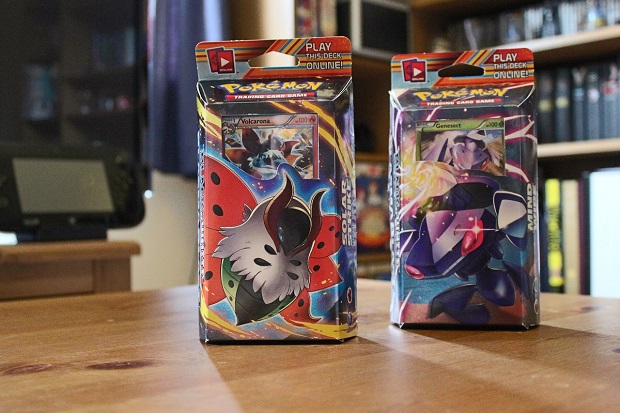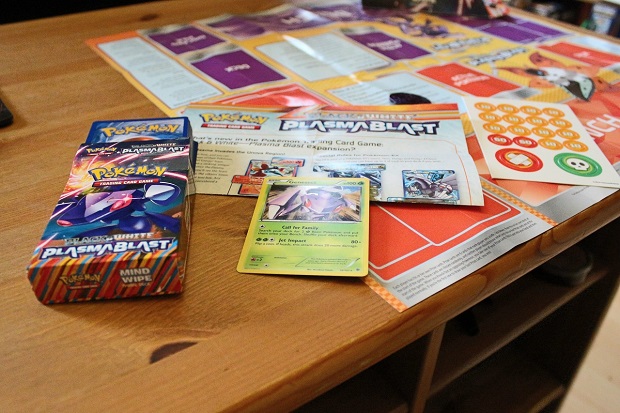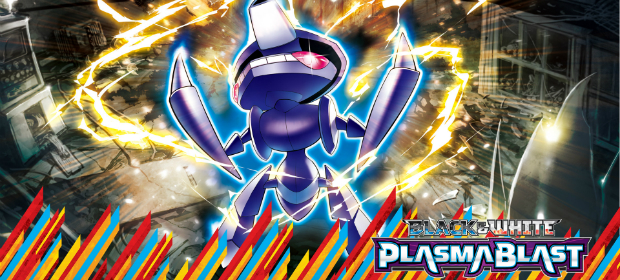If you grew up around the explosion of Pokémon in the mid to late nineties, then there’s a good chance that you’ve at least come into contact with the Pokémon Trading Card Game. Kids would trade the cards in the playground, marvel at each other’s collection and sometimes – just sometimes – they would actually get down to the actual point of the cards and play a game. I don’t remember this part of it being a regular occurrence though.
Now we’ve all grown up (or at least gotten older) and can appreciate the gameplay of the Pokémon Trading Card Game along with the collector mentality of it all. With the release of Pokémon X & Y a couple of weeks ago, we thought it would be a good idea to sit down with the latest expansion for the game – Plasma Blast – get ourselves a couple of themed decks, and get some game time in.
The two themed decks that we were able to take a look at were Mind Wipe and Solar Strike. Both of these decks focused on two of the different types of energy that this particular TCG uses, with Solar Strike concentrating on Fire and Water and Mind Wipe concentrating on Grass and Psychic abilities. This means that if you’re playing with one of the themed decks against someone with a different deck, you can be sure of some interesting gameplay tactics as some of the Pokémon are vulnerable to attacks from Pokémon of the opposite type. For example, as you would expect, a Grass type Pokémon might be vulnerable to attacks from a Fire type. So it’d probably be a good idea, if you’ve got a Grass type as your currently active Pokémon and your opponent swaps theirs for a Fire type, to get yours out of there as quickly as possible; possibly even for a Water type if you’ve got one in your current deck.

As with all trading card games, the whole point is to build up your own deck and, as such, the decks that are provided in both Mind Blast and Solar Strike, feel a little bit lacklustre and lacking in certain areas. For example, we found that unless the decks were shuffled exceptionally well, there could be entire rounds of the game where neither of the players were able to do anything because they didn’t have any energy cards to play. This, of course, could have been rectified by making sure that the energy cards that are provided are evenly spaced throughout the deck, but we decided to play just as most people would; simply taking the cards out of the packaging, shuffling them slightly and then getting down to some gameplay.
It’s simple enough, especially if you’ve played some other trading card games which are often slightly more complicated. Even Blizzard’s Hearthstone – which we recently previewed – is more confusing than Pokémon. However, that’s a good thing, considering the targeted age range for this particular game. Each player has a deck of 60 cards, and deals 7 off them from the top at the start of the game. They then choose at least one basic Pokémon from these 7 and set it as their active Pokémon. Any Pokémon that are left in that original 7 can be set on the bench, ready to be used if your active Pokémon gets knocked out or if – during the course of the match – they succumb to any of the other ailments they may fall under (paralysis, sleep, poisoned, etc). Attacks are made through the collection of energy cards, which can be placed on a Pokémon once each turn and once your Pokémon has enough energy to perform an attack, you simply remove that energy from the Pokémon (essentially ‘spending’ it) and then apply damage counters to your opponent based on how hard you attacked; making sure to take into account any resistances or weaknesses they may have.

It sounds a lot more complicated in writing than it actually is to get into it and play. In fact, the instructions cover only a single side of a piece of paper and are broken down far enough for anyone to understand. Even the game “board” – a piece of paper, essentially – has a couple of the more useful rules printed right next to the play area, for immediate referencing should you need it.
In order to help the player take down the members of Team Plasma – which can be rather difficult considering that certain things only happen when a Team Plasma Pokémon is on the battlefield – there are a selection of new EX cards included with the expansion. None of these cards are included in the themed decks that were played for review, but for the collectors out there, as well as the serious players who want to have that edge on their opponent, expect to be buying a hell of a lot of booster packs if you want to get your hands on one – or all – of these relatively rare Pokémon.
VERDICT: All in all, if you’ve played the Pokémon Trading Card Game before, then you’ll feel right at home with this expansion. The collector in people will gravitate towards it thanks to the exclusive Pokémon – Genesect and Volcarona – and those of you that have been playing the game right from its inception will enjoy the additional elements and attacks that the Team Plasma cards bring to the fold. If you’re a fan of TCGs, collecting cards or just a fan of Pokémon and want to get into the more physical side of collecting Pokémon and battling them, then the Plasma Blast expansion is as good a place to start as any.
[nggallery id=1648]






